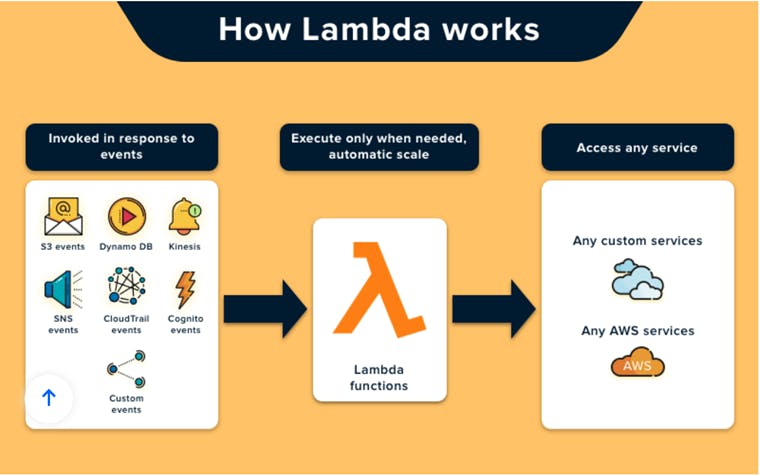Serverless Computing: Building Scalable Applications with AWS Lambda
Unleashing the Power of AWS Lambda for Seamless Development and Scalability of Applications
Serverless computing has revolutionized the way developers build and deploy applications. AWS Lambda, a leading serverless computing platform from Amazon Web Services, allows you to run code without provisioning or managing servers. In this comprehensive guide, we will explore the fundamentals of serverless computing and demonstrate how to build scalable applications using AWS Lambda.
What is Serverless Computing?
Serverless computing is a cloud computing model where cloud providers automatically manage the infrastructure, scaling, and maintenance thus allowing developers to focus solely on writing code. With serverless computing, you don't need to worry about server provisioning, capacity planning, or scaling. Instead, you can focus and work on your code and application and pay only for the actual compute resources consumed during code execution. Another benefit of serverless computing is that it allows us to scale applications automatically. It can adjust the capacity of your application by modifying throughput and memory.
The AWS Service for serverless computing is AWS Lambda.
Getting started with AWS Lambda ☁️
AWS Lambda lets its users run code without the need of provisioning any servers or managing them. When we use AWS Lambda, we only pay for the compute time that we consume, meaning that we only pay when our code is running. And it requires zero administration!
Before we get started, make sure you have the following Prerequisites :
An AWS account (if you don't have one, sign up at AWS).
AWS Command Line Interface (CLI) installed and configured with appropriate credentials.

Creating Your First Lambda Function
So basically how AWS Lambda works is first we upload our code to Lambda, we then set our code to trigger from an event source such as another application or maybe another AWS Service like CloudWatch. After this setup, Lambda would only run the code whenever triggered and we will only pay for the compute time we use.
Sign in to AWS Console: Log in to your AWS account and navigate to the AWS Lambda service.
Create Function:
Click the "Create function" button.
Choose "Author from scratch."
Fill in the function name, runtime (e.g., Node.js, Python), and execution role (you can create a new role with basic Lambda permissions).
Write Code:
In the Lambda function code editor, write your function code. For example, let's create a simple function in Node.js:
// Define the Lambda function's entry point exports.handler = async (event) => { // Return a response object with a status code and body return { // Set the HTTP status code to 200 (OK) statusCode: 200, // Set the response body as a JSON string body: JSON.stringify('My first AWS Lambda function!'), }; };
Configure Trigger:
- You can configure triggers for your Lambda function, such as an API Gateway, an S3 bucket, or an event from another AWS service.
Test Your Function:
- You can test your Lambda function with sample event data.
Create Function:
- Click the "Create function" button to create your Lambda function.
Deploying and Scaling Lambda Functions
AWS Lambda automatically scales your functions in response to incoming traffic. You don't need to worry about provisioning or managing servers.
Concurrency: AWS Lambda manages the number of function executions in response to incoming requests. You can configure the maximum concurrency for your function.
Scaling: Lambda automatically scales out to handle a large number of requests, and it scales back in when the load decreases.
AWS Lambda Pricing Model
AWS Lambda pricing is straightforward and cost-efficient:
Request-Based Pricing: You pay for each request made to your Lambda functions. This includes both manual invocations and events that trigger your functions.
Compute Time: You're billed for the memory allocated to your function and the time it takes to run. You pay only for the actual compute resources used during execution.
No Idle Costs: Importantly, there are no charges when your functions are idle. You're only billed when your code is actively processing requests or events.
This pricing model offers transparency and cost savings, making AWS Lambda an excellent choice for building scalable and cost-effective serverless applications.
Use Cases for AWS Lambda
AWS Lambda is incredibly versatile and can be used for various use cases:
API Backends: Create serverless API endpoints using API Gateway and Lambda.
Data Processing: Process data from various sources, such as S3, DynamoDB, and Kinesis.
Real-time File Processing: Automatically process files uploaded to S3 buckets.
IoT Applications: Handle IoT device data and trigger actions in real time.
Scheduled Tasks: Run code at specified intervals using CloudWatch Events.
Chatbots: Build serverless chatbots using services like Lex and Lambda.
Best Practices
When working with AWS Lambda, consider the following best practices:
Optimize your functions for cost and performance.
Use environment variables for configuration.
Implement error handling and retries.
Monitor your functions using CloudWatch Logs and Metrics.
Conclusion
AWS Lambda isn't just a tool, it's your sidekick in the world of serverless computing. It liberates you from the issues of server management, allowing you to focus on what you do best – building and innovating incredible applications.
With Lambda, you're not just saving money, you're spending it wisely. You pay only for what you use, without money being wasted on idle resources. And when it comes to scaling, Lambda has your back. Whether you have one user or a million, it adapts seamlessly to the demand. No more sleepless nights worrying about capacity planning.
So, embrace AWS Lambda, follow the best practices, and watch as your applications become efficient, responsive, and hassle-free! Say goodbye to server worries and hello to a world of endless possibilities in cloud development! 🚀
